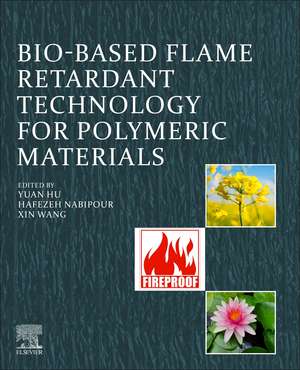Bio-based Flame-Retardant Technology for Polymeric Materials
Editat de Yuan Hu, Hafezeh Nabipour, Xin Wangen Limba Engleză Paperback – 24 aug 2022
Throughout the book, the latest progress in the field is critically reviewed, and there is a continual emphasis on novel approaches to achieve enhanced properties and performant materials. This is an essential guide for all those with an interest in innovative, sustainable flame retardant additives for polymeric materials, including researchers, scientists, advanced students, and more.
- Explains innovative techniques for the preparation of bio-based flame retardant mechanisms, analyzing properties, performance and applications
- Offers in-depth coverage of a range of sources, including cellulose, lignin, cardanol, chitosan, eugenol, vanillin, furan, alginate and vegetable oils
- Presents the latest advances in the field, serving as a novel resource to advanced students, researchers and R&D professionals in academia and industry
Preț: 1076.97 lei
Preț vechi: 1409.57 lei
-24% Nou
Puncte Express: 1615
Preț estimativ în valută:
206.07€ • 215.18$ • 170.17£
206.07€ • 215.18$ • 170.17£
Carte tipărită la comandă
Livrare economică 08-22 aprilie
Preluare comenzi: 021 569.72.76
Specificații
ISBN-13: 9780323907712
ISBN-10: 0323907717
Pagini: 478
Ilustrații: 230 illustrations (30 in full color)
Dimensiuni: 191 x 235 mm
Greutate: 0.84 kg
Editura: ELSEVIER SCIENCE
ISBN-10: 0323907717
Pagini: 478
Ilustrații: 230 illustrations (30 in full color)
Dimensiuni: 191 x 235 mm
Greutate: 0.84 kg
Editura: ELSEVIER SCIENCE
Cuprins
1. Introduction to Bio-Based Materials for Flame Retardancy
2. Synthetic Approaches to Bio-Based Flame Retardant Polymeric Materials
3. Fire Testing Methods of Bio-Based Flame Retardant Polymeric Materials
4. Cellulose- Based Flame Retardant for Polymeric Materials
5. Lignin and Its Derivatives: Potential Feedstock for Renewable Flame Retardant Polymers
6. Cardanol- Based Flame Retardant Polymeric Materials
7. Chitosan- Based Flame Retardant Polymeric Materials and Their Applications
8. Development of Novel Flame Retardant Polymers Based on Eugenol
9. Flame Retardants from Starch: Phosphorus Derivatives of Isosorbide
10. Flame Retardant Polymeric Materials from Renewable Vanillin
11. Furan-Based Flame Retardant Polymeric Materials
12. Advances in Alginate-Based Flame Retardant Polymeric Materials
13. Phenolic-based Phosphorus Flame Retardants for Polymeric Materials
14. Recent advances in the development and application of P- and N-modified starch derivatives as novel biobased flame retardants from renewable resources
15. Development of Natural Fiber Reinforced Flame Retardant Polymer Composites
16. Vegetable Oils-based Flame Retardant Polymeric Materials
17. Preparation, Flame Retardancy and Mechanism of Natural Fiber/Polymer Composites
18. Perspective and Challenges in Using Bio-Based Flame Retardant
2. Synthetic Approaches to Bio-Based Flame Retardant Polymeric Materials
3. Fire Testing Methods of Bio-Based Flame Retardant Polymeric Materials
4. Cellulose- Based Flame Retardant for Polymeric Materials
5. Lignin and Its Derivatives: Potential Feedstock for Renewable Flame Retardant Polymers
6. Cardanol- Based Flame Retardant Polymeric Materials
7. Chitosan- Based Flame Retardant Polymeric Materials and Their Applications
8. Development of Novel Flame Retardant Polymers Based on Eugenol
9. Flame Retardants from Starch: Phosphorus Derivatives of Isosorbide
10. Flame Retardant Polymeric Materials from Renewable Vanillin
11. Furan-Based Flame Retardant Polymeric Materials
12. Advances in Alginate-Based Flame Retardant Polymeric Materials
13. Phenolic-based Phosphorus Flame Retardants for Polymeric Materials
14. Recent advances in the development and application of P- and N-modified starch derivatives as novel biobased flame retardants from renewable resources
15. Development of Natural Fiber Reinforced Flame Retardant Polymer Composites
16. Vegetable Oils-based Flame Retardant Polymeric Materials
17. Preparation, Flame Retardancy and Mechanism of Natural Fiber/Polymer Composites
18. Perspective and Challenges in Using Bio-Based Flame Retardant
